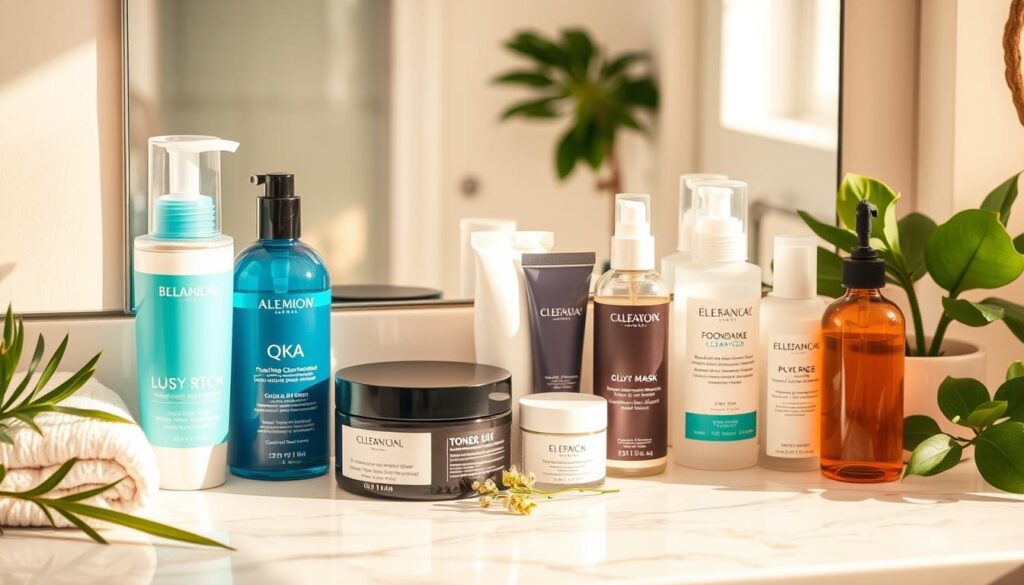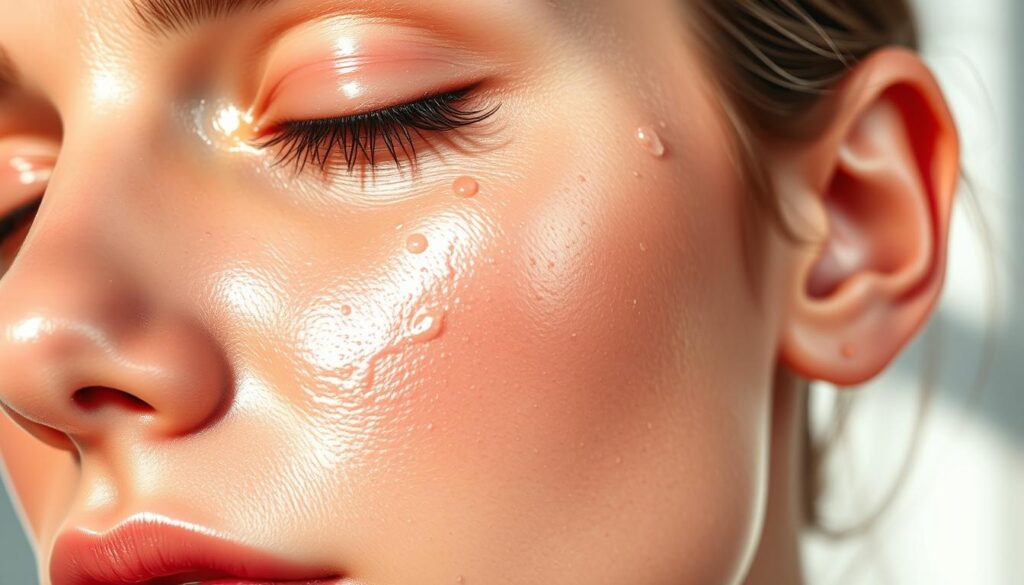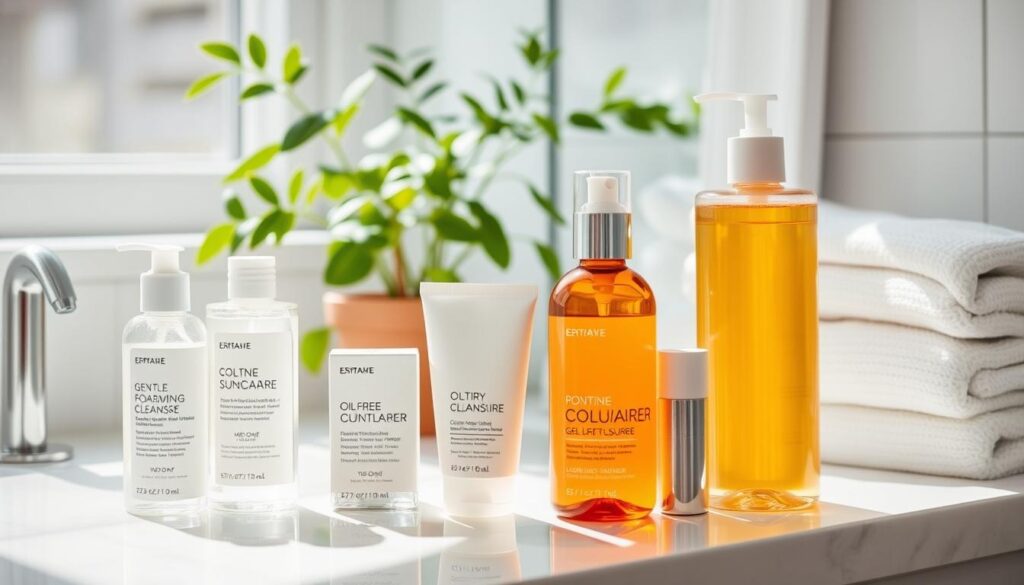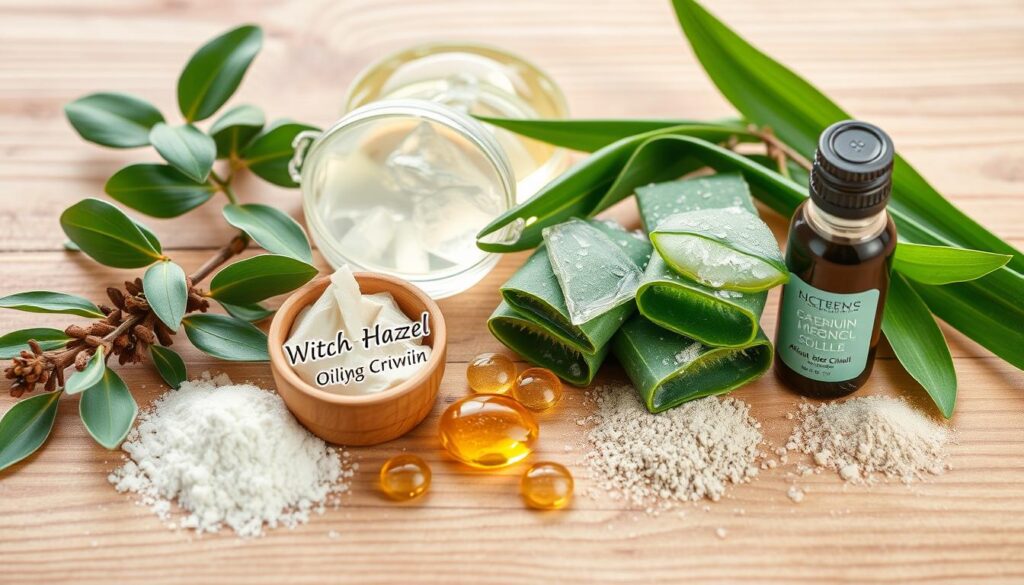
Are you tired of battling constant shine and feeling like your face is an oil slick by midday? What if you could transform your skincare routine for oily skin and achieve that perfect, balanced complexion?
Managing oily skin can be tough. But with the right oil control strategy, you can minimize excess sebum, reduce shine, and keep your skin looking fresh and clear. People with oily skin often deal with enlarged pores, persistent shine, and more acne.
A targeted skincare routine for oily skin is not just about reducing oil—it’s about creating a balanced approach that addresses your skin’s unique needs. Understanding your skin’s specific characteristics and implementing the right techniques can make a significant difference in your overall skin health.
This comprehensive guide will walk you through expert tips, product recommendations, and essential strategies to help you effectively manage and control oily skin. From morning rituals to nighttime treatments, you’ll discover how to achieve a radiant, matte complexion that looks and feels amazing.
Understanding Oily Skin: Causes and Characteristics
Oily skin is a common issue affecting millions globally. Knowing how sebum is produced helps in finding the right skincare for oily skin.

Identifying Your Skin Type
Spotting oily skin means looking for certain signs:
- Shiny look, especially in the T-zone
- Large, visible pores
- Tendency to get acne and blackheads
- Skin feels oily soon after washing
Common Triggers for Excess Sebum Production
| Trigger | Impact on Sebum Production |
|---|---|
| Hormonal Changes | Increases oil during puberty, menstruation, and stress |
| Genetic Factors | Controls how much oil skin naturally makes |
| Diet | High glycemic foods boost sebum production |
“Understanding your skin is the first step to managing its unique characteristics.” – Dermatology Experts
Impact of Climate and Environment
Environmental factors greatly affect sebum production. Humid climates make skin oilier, while dry ones might cause glands to work harder. Pollution and stress can worsen oily skin.
Knowing these factors helps in creating skincare plans that control oil and keep skin healthy.
Essential Morning Skincare Routine for Oily Skin
Creating the right skincare routine for oily skin is key. It balances controlling oil and keeping skin healthy. The morning is important for managing oil and getting ready for the day.

Start with a gentle, foam cleanser made for oily skin. Look for products that remove oil but keep moisture in.
- Use lukewarm water to prevent over-stimulating oil glands
- Choose cleansers with salicylic acid or tea tree oil
- Pat skin dry with a clean, soft towel
Next, use an alcohol-free toner to balance your skin’s pH. Opt for toners containing niacinamide or witch hazel, which help with pores and oil control.
“The key to managing oily skin is gentle, consistent care that doesn’t trigger more oil production.”
For hydration, pick lightweight, oil-free moisturizers. They give nutrients without adding shine. Water-based gel moisturizers are best for oily skin.
- Apply a pea-sized amount of moisturizer
- Gently massage into skin using upward motions
- Wait 2-3 minutes before applying sunscreen
Sunscreen is a must. Choose a broad-spectrum, non-comedogenic sunscreen with at least SPF 30. It should not clog pores or make skin oilier.
Finish with a mattifying primer. It makes a smooth base for makeup and controls shine all day.
Best Ingredients to Control Excess Oil Production
Managing oily skin needs smart choices in skincare. The right ingredients can change how your skin looks and feels.

It’s not about using harsh products. Instead, pick ingredients that keep your skin in balance. The right mix can cut down on shine, lessen breakouts, and make your skin smoother.
Salicylic Acid: Your Oil-Control Powerhouse
Salicylic acid is a top choice for oily skin. This beta-hydroxy acid (BHA) goes deep into pores. It breaks down oil and dead skin cells that clog pores.
- Unclogs pores and prevents blackheads
- Reduces inflammation and redness
- Provides gentle chemical exfoliation
Niacinamide: The Sebum Regulator
Niacinamide is great for oily skin. It controls sebum and strengthens the skin’s barrier. This ingredient helps achieve a balanced look.
| Benefit | Impact on Skin |
|---|---|
| Reduces Oil Production | Minimizes shine and greasy appearance |
| Pore Minimizing | Tightens and refines skin texture |
| Anti-Inflammatory | Calms irritated, acne-prone skin |
Clay Masks: Natural Oil Absorption Solution
Clay masks are top picks for oily skin. They soak up excess oil. These natural ingredients clean deep and leave your skin feeling fresh.
“Clay masks are like a reset button for your skin’s oil production.” – Dermatology Expert
Choose clay masks with kaolin or bentonite clay. They offer the best oil control and skin clarity.
Nighttime Skincare Routine for Oily Skin
Creating the right skincare routine for oily skin at night is key. You need to pick the right products and apply them carefully. This is the best time to fix your skin, reduce oil, and stop breakouts.
“Nighttime is when your skin enters recovery mode, making it crucial to choose non-comedogenic products that support natural healing processes.”
A good nighttime skincare routine for oily skin has three main steps:
- Double Cleansing: Remove makeup, sunscreen, and daily dirt
- Chemical Exfoliation: Clear pores and help skin cells renew
- Lightweight Hydration: Moisturize without adding too much oil
Start with an oil-based cleanser, then a water-based one. This combo gets rid of all dirt and impurities. Choose cleansers made for oily skin that won’t clog pores.
Next, use a chemical exfoliant with salicylic acid or glycolic acid. These help control oil and keep pores open. Use it 2-3 times a week for clear, healthy skin.
Finally, apply a light, gel moisturizer. Go for non-comedogenic ones that hydrate without extra oil. Ingredients like niacinamide help balance oil and keep skin healthy.
“The right nighttime routine can transform oily skin from a challenge to a manageable, glowing complexion.”
Common Mistakes to Avoid in Your Skincare Routine
Creating the right skincare routine for oily skin needs focus. Many people unknowingly make mistakes that can make their skin worse.
The Dangers of Over-Cleansing
Too much cleansing might seem like a good idea for oily skin. But it can actually make things worse. When you take away too many natural oils, your skin makes more sebum to replace them. This leads to more oil being produced.
- Limit face washing to twice daily
- Use gentle, non-comedogenic cleansers
- Avoid harsh scrubbing techniques
Moisturizing Myths Debunked
Many think moisturizing isn’t needed for oily skin. But, it’s actually important for controlling oil and preventing too much sebum.
“Hydration is key to balanced skin, even for those with oily complexions.” – Dermatology Experts
Incompatible Product Combinations
Using the wrong skincare products together can mess up your skin’s balance. Some combinations can make your skin more inflamed and produce more oil.
| Avoid Mixing | Potential Skin Impact |
|---|---|
| Retinol + Vitamin C | Increased skin irritation |
| Benzoyl Peroxide + Salicylic Acid | Excessive dryness |
| Multiple Exfoliants | Compromised skin barrier |
Knowing these common mistakes can help you create a better skincare routine. This way, you can manage oily skin and get a healthy, balanced look.
Recommended Products and Treatments for Oily Skin
Managing oily skin needs a smart plan with the right skincare. The right products can change your skincare game and control oil.
- Salicylic acid cleansers
- Lightweight gel moisturizers
- Niacinamide serums
- Oil-free sunscreens
Pore minimizers are key to controlling shine and shrinking pores. Look for products with:
- Zinc
- Clay extracts
- Green tea
- Witch hazel
“The key to managing oily skin is selecting products that balance oil production without stripping the skin’s natural protective barrier.”
Blotting papers are a quick fix for mid-day shine. These thin, absorbent sheets quickly soak up excess oil without messing with makeup.
| Product Type | Key Benefits | Recommended Frequency |
|---|---|---|
| Clay Masks | Deep pore cleansing | 1-2 times weekly |
| Niacinamide Serum | Regulate sebum production | Daily |
| Salicylic Acid Toner | Exfoliate and unclog pores | Every other day |
Professional treatments like chemical peels and LED light therapy can help too. Talk to a dermatologist to create a skincare plan that fits your needs.
Managing Oily Skin in Different Seasons
Keeping your skin healthy all year round means making changes with the seasons. Each season brings its own challenges for oily skin, so you need to be flexible with your skincare.
Changing seasons can be hard for oily skin types. Each climate has its own effects on sebum and skin health.
Summer Skincare Adjustments
Summer makes your skin produce more oil, so your skincare routine is key. Here are some tips:
- Use lightweight, gel-based moisturizers
- Select non-comedogenic sunscreens
- Carry oil-absorbing sheets for midday touch-ups
- Opt for mattifying primers before makeup
Winter Care for Oily Skin
Winter is different because of the dry air. It can make your skin produce more oil. Here’s what to do:
- Choose hydrating serums with hyaluronic acid
- Use gentle, alcohol-free cleansers
- Implement light, water-based moisturizers
- Avoid heavy cream-based products
Monsoon Skincare Tips
Monsoon season brings high humidity, which can make oily skin worse. Here’s how to control oil:
- Use clay-based masks weekly
- Select antibacterial cleansers
- Keep skin dry and clean
- Use lightweight, quick-absorbing serums
“Adapting your skincare routine seasonally is key to maintaining balanced, healthy skin.”
Sticking to a skincare routine that changes with the seasons helps keep oil in check.
Conclusion
Creating a good skincare routine for oily skin takes time, patience, and effort. It’s not easy, but the right steps can make a big difference. With the right products and strategies, you can get healthy, balanced skin that feels and looks great.
Knowing your skin is key to a good skincare routine. Every step, from washing to moisturizing, helps control oil. Your skin’s needs can change with the weather, hormones, and seasons.
Skincare is a journey of learning and trying new things. Try different methods and see how your skin reacts. Getting advice from a dermatologist can also help you find the best way to care for your oily skin.
By accepting your skin and sticking to a skincare routine, you can get better results. Keep learning about new skincare ideas and trust yourself to take care of your skin.
FAQ
How do I know if I have oily skin?
Oily skin looks shiny, especially on your forehead, nose, and chin. You might get breakouts often. If blotting paper picks up a lot of oil, you likely have oily skin.
Can I moisturize if I have oily skin?
Yes, you can! It’s important to moisturize oily skin. Use lightweight, non-comedogenic moisturizers. Look for gel or water-based formulas with niacinamide or hyaluronic acid.
How often should I cleanse my face if I have oily skin?
Cleanse twice a day – morning and night. Use a gentle cleanser with salicylic acid. Avoid over-cleansing to prevent more oil.
What ingredients are best for controlling excess oil?
For oily skin, use salicylic acid, niacinamide, clay, and zinc. These ingredients help control shine and pores.
Can diet affect my oily skin?
Yes, diet affects oil production. Avoid high-glycemic foods, dairy, and processed foods. Eat antioxidant-rich foods and stay hydrated.
How can I manage shine throughout the day?
Use blotting papers and carry a mattifying powder. Apply oil-free primers and setting sprays for oily skin.
Are there specific sunscreens for oily skin?
Yes! Choose lightweight, oil-free sunscreens. Look for gel or mineral sunscreens. Brands offer specific oily and acne-prone skin formulas.
How do seasonal changes affect oily skin?
Oily skin changes with seasons. Summer humidity increases oil, while winter dehydration triggers more oil. Adjust your skincare routine seasonally.
